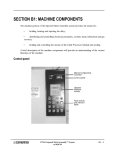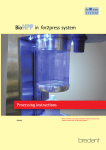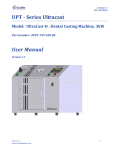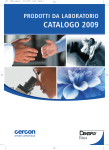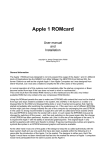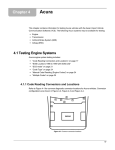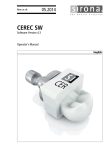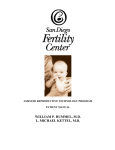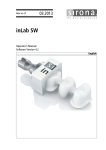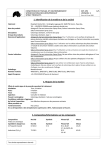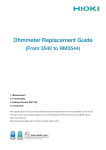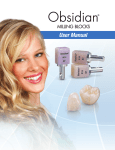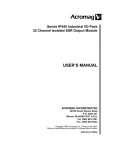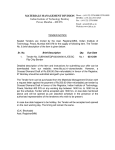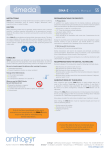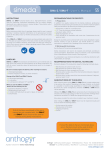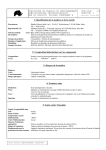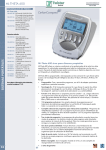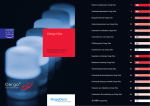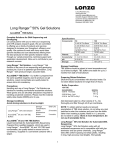Transcript
User instructions SUPRANIUM® 0344 Made in Germany Nickel based dental metal-ceramic alloy Beryllium and gallium free Ni ISO 22674 ISO 9693 Elephant Dental B.V. Chemical composition in mass percentage Physical and alloy properties (target values) Ni Cr Mo Nb Co Fe Si, Mn Type : Colour : Vickers hardness* : Modulus of elasticity* : Yield strength* : Tensile strength* : Elongation* : 61.0 21.5 9.0 4.0 2.0 1.5 < 1.0 Verlengde Lageweg 10 1628 PM Hoorn, The Netherlands Tel: +31 229 25 90 00 Fax: +31 229 25 90 99 E-mail: [email protected] www.elephant-dental.com Density IV extra hard Melting Range Grey 220 (HV10) Casting temperature 200 GPa 400 MPa (Rp 0.2) CTE 25-500°C 710 MPa * after firing 30% Indication Nickel based dental alloy for fixed metal-to-ceramic dental restorations, such as crowns, bridges, etc. Contra-indication Supranium contains nickel, it should not be used by or for people with a known nickel allergy, or with an allergy or sensitivity to one of the other components. Adverse effects Certain components of the alloy may cause an allergic reaction or sick feeling, due to electro-chemical reactions. Nickel is classified as a suspect carcinogen (R40). For processing precautions see MSDS. Interactions In exeptional cases occlusal or approximal contact with different alloys may cause a sick feeling due to electrochemical processes or a slight sensation of electrical pulses, due to the difference in electric potential. Processing instructions 1. Waxing up To ensure problem-free casting of the sub-structure, do not model crown walls thinner than 0.4 – 0.5 mm to ensure that wall thickness after finishing is at least 0.25 mm. Form crowns and pontics in line with anatomical tooth shapes to permit uniform ceramic coating (incisal max. 2 mm, occlusal max.1.5 mm). Avoid sharp edges and receding areas in the pattern; the transition from metal to ceramic should be smooth. The lingual metal end should be located below the incisal zone to avoid spalling caused by unwanted pressure/tensile stresses. 2. Spruing Direct method: Crowns and pontics must be provided with a sprue of 3 mm diameter; use sprues with reservoir (diameter 5, 6 or 7 mm) for full-cast crowns and pontics to avoid shrinkage cavities during solidification. Distance between reservoir and cast: 1 to 2 mm. Indirect method: For casting with transverse sprue, the following dimensions apply: sprues to pattern = diam. 3 mm, transverse sprue = diam. 5 mm, feed channels to the transverse sprue = diam. 5 mm. Distance from transverse sprue to cast = 1 to 2 mm. Indirect method for pontics and full-cast crowns: particularly short distance from sprue button to cast. Arrange sprues according to the direction of metal flow. Attach wax marking pin to indicate the position of the cast on the base of the casting ring. Sprues should be as short as possible. Do not place the object to be cast in the hottest point in the casting ring. 3. Stress-relieving the pattern Use stress-relieving agent indicated by the manufacturer. 4. Investing A fine-grained, phosphate-bonded, graphite- and gypsum-free investment for crown and bridge work, is ideally suited to producing accurately fitting casts. We recommend, Carrara Universal Dustless (Cat. no. 232976050). 5. Preheating Follow the instructions from the investment manufacturer. For Carrara Universal Dustless, we recommend bench setting the moulds for one hour. Place the moulds in a cold furnace and heat them to 982°C (1800°F). Hold for one hour. 6. Required metal quantities The number of SUPRANIUM® ingots required for a specific casting operation is determined by multiplying the weight of the wax pattern (g/including sprues) by the density of SUPRANIUM® (8.4 g/cm3). A SUPRANIUM® ingot weights 6 g. 7. Insert the casting ring Insert the heated casting ring in the centrifugal casting arm of the casting machine such that the marking point is pointing in the opposite direction of the rotational direction of the casting arm. 8. Casting a) With motorized centrifugal caster for openflame melting and casting Ignite oxy-acetylene or oxy-propane mixture. Fully open both valves and adjust the flame by reducing the flow of acytelene or propane until approx. 3 mm long blue cones become visible at the multiple-orifice tip. Pressure values: acetylene = 0.7 bar, oxygen = 1.9 bar or propane = 0.3 bar, oxygen = 1.5 bar. This gives a neutral flame which is essential for melting SUPRANIUM®. Place SUPRANIUM® ingots in the preheated crucible. Keeping the torch about 40 mm above the top of the crucible and rotating the tip, heat the ingots evenly until they form a molten bath. Initiate centrifugal action immediately after molten bath has formed. b) With atmospheric high-frequency melting and centrifugal casting unit Do not use graphite crucibles. Initiate centrifugal action as soon as the ingots have melted and the shadow has disappeared. c) With vacuum high-frequency melting and centrifugal unit This type of unit can be used for melting and casting SUPRANIUM under vacuum conditions. Initiate the centrifugal action as soon as the ingots have melted and the shadow has disappeared. 9. Removal After casting, allow the casting ring to cool down in air. Carefully remove the cast from the casting ring. Carefully remove residual investment compound. Clean the cast by blasting with aluminium oxide abrasive (90 – 125 μm). Do not blast crown margins directly. 10. Finishing Finish SPRANIUM® sub-structures with sharped-edged hard metal cutters and ceramic-bonded grinding stones without applying too much pressure. Grind in one direction only. Use dust collector. Do not apply a rubber polishing material to the surface to be veneered. Avoid sharp edges and receding areas. With plastic veneering: Attach retentions or use silanizing process and finish in the usual way. Veneer according to manufacturer´s instructions. : 8.4 g/cm3 : 1,300-1,360°C / 2,372-2,480°F : 1,545°C/ 2,813°F : 13.9 μm/m.K 11. Preparation and oxidation of the sub-structure Sandblast the sub-structure with aluminium oxide (90 – 125 μm). Use a steam jet or clean with hot distilled water. Oxidize the cleaned sub-structure for one to two minutes in the porcelain furnace at 900°C (1,652°F). The colour of the oxide layer should be uniform. Sandblast the sub-structure with aluminium oxide (90 - 125 μm). Use a stem jet or heated distilled water. 12. Working the body porcelain Supranium is suitable for firing normal expanding ceramic. For instance Antagon Interaction. Apply and fire the ceramic according the ceramic manufacturer’s user instructions. Step 1 s Oxidize in accordance with step 11. Step 2 s Apply a total masking layer of Vi-Comp NE bonder (art. nr. 005010058): a) mix Vi-Comp NE bonder with Ducera B Liquid (art. nr. 05368271514) to a creamy substance; b) apply the Vi-Comp NE bonder in a fully masking layer; c) follow the firing-procedure below: Starting temp. Dry Vacuum starting temp. 400°C 4 minutes 400°C Rate of heat increase Final temp. Hold time 60°C/min. 980°C 2 minutes (1 min. with vacuum and 1 min. without vacuum) Step 3 After this bonder firing procedure, continue with the Antagon Interaction user manual at item number 2b (Opaque firing). All firing processes need to be cooled quickly to normal (0 - 2 minutes). Do not overheat the alloy! This could lead to air bubbles in the fired ceramic layer. Overheating can be recognized by an uneven oxide layer/colour or by a rough metal surface. 13. Soldering For soldering SUPRANIUM® we recommend a mixture of oxygen and propane or butane or natural gas. a. Prior to firing SUPRANIUM® sub-structures can be soldered with DENTI-LOT and its own special-purpose flux. The soldering gap must not be wider than 0.2 mm. The surface to be soldered must be of adequate size and be polished to a metallic lustre. Keep the soldering block as small as possible. Heat the soldering block to 500°C (932°F) in the preheating furnace. As SUPRANIUM´s thermal conductivity is low and this entails a risk of the surface overheating while the working temperature of the solder has not yet been reached on the inside of the part to be soldered, a low torchflame setting is necessary. Heat up the solder and immerse it in the flux. Slowly heat the part to be soldered until red hot. Apply the flux-laden solder to the soldering point so that the flux can flow into the soldering gap. Continue to heat up the part until white hot. Hold the soldering tip to the heated soldering point and allow the DENTILOT to flow into the soldering gap. Allow to cool in air and blast clean. b. After firing (furnace soldering) Embed part to be soldered at an incline. Keep the soldering block as small as possible. Ensure that no soldering investment comes into contact with the porcelain. Paint separator onto the porcelain around the soldering gap to avoid discoloration. Good results are obtained with lowmelting white gold alloy solders. Apply a thin layer of flux to the soldering point, which must have a sufficiently large surface area and be polished to a metallic lustre. Ensure that the flux does not come into contact with the porcelain. Place solder onto soldering point and preheat for about 15 minutes in the preheating furnace at 500°C ( 932°F). Remove the soldering block from preheating furnace and insert in porcelain furnace. Set the porcelain furnace at 70°C (158°F) above the working temperature of the solder used. Maintain the soldering temperature for 2 to 3 minutes without vacuum. After the soldered part has cooled down, carefully remove from the soldering investment and finish. 14. Re-use For ceramic veneering it is recommended that only new material is used, as any impurities might impair the ceramic bond. For plastic veneering and non-veneered crowns, however, SUPRANIUM® sprue cones can be used, provided that oxides and residual investment compound have been completely removed. SUPRANIUM® can be re-used 3 to 4 tmes provided a mixture ratio by weight of: 1 : max. 1 (SUPRANIUM® ingots) (SUPRANIUM® sprue cone) is observed. Important notes: a) If possible, do not gold plate SUPRANIUM®. The chemical composition of various goldplating materials offers no guarantee for sufficient corrosion resistance; local corrosion of the goldplating layer may later lead to cracks and spalling. b) For porcelain removal, SUPRANIUM® sub-structures should not remain in the hydrogen fluoride bath for longer than two hours. c) See www.elephant-dental.com for material safety data sheets (MSDS).
